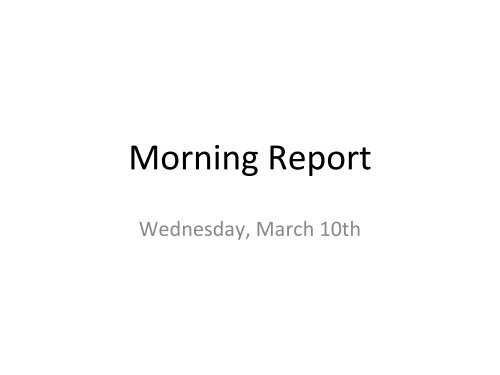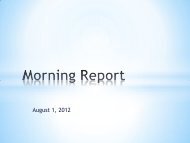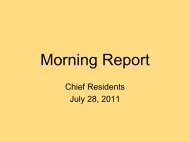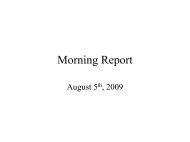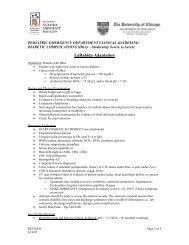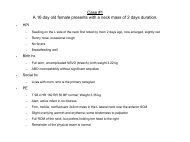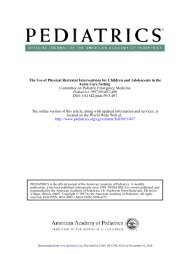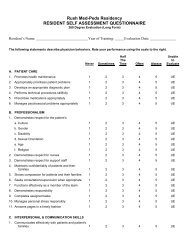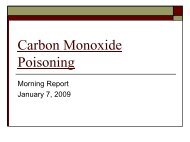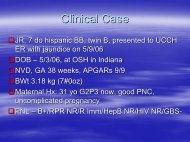Cyclic neutropenia
Cyclic neutropenia
Cyclic neutropenia
Create successful ePaper yourself
Turn your PDF publications into a flip-book with our unique Google optimized e-Paper software.
Morning Report<br />
Wednesday, March 10th
You are following up labs at clinic…<br />
WBC: 8.2<br />
Diff: 3% Neutrophils, 71% lymphocytes, 17%<br />
monocytes, 8% eosinophils<br />
Hgb: 12.3<br />
Plts: 450<br />
Anything worrisome???
• What are the key questions on history?<br />
• What physical exam finding may help you with<br />
the diagnosis?
Physical Exam
Differential Diagnosis<br />
• Extrinsic to Marrow<br />
• Acquired Disorder of Marrow<br />
• Intrinsic to Marrow
Antineutrophil Antibodies
What’s Wrong With This<br />
Picture???<br />
Normal
What’s Wrong With This<br />
Picture???<br />
No Mature Neutrophils<br />
Dx: Immune Neutropenia
What’s Wrong With This<br />
Picture???<br />
No Bands or Mature Neutrophils. Mainly Immature<br />
Dx: Severe Congenital Neutropenia
Severe Congenital Neutropenia<br />
• ANC
Back to Our Patient<br />
• Recurring Oral Ulcers; sometimes w/fever<br />
• Father with hx “blood problem”<br />
• No hx hospitalizations or severe infx<br />
• Growing Appropriately<br />
• Physical Exam normal except oral lesions<br />
• Labs confirmed diagnosis
<strong>Cyclic</strong> Neutropenia<br />
• Autosomal Dominant; mutation ELA‐2 (diff location<br />
than Kostmann)<br />
• 21 +/‐ 5 day cycle with <strong>neutropenia</strong> 3‐6 days<br />
• May be symptomatic at nadir<br />
– Usually fever, oral ulcers, gingivitis, pharyngitis, skin<br />
– PNA, NEC, peritonitis, E. Coli or Clostridium sepsis<br />
• Confirm diagnosis by checking ANC 2‐3x weekly for 4‐6<br />
weeks to establish pattern<br />
• Treatment Dependent on Severity
Take Home Points<br />
• ANC varies with age and race<br />
• History and Physical provide key info to narrow DDx<br />
<strong>neutropenia</strong><br />
• Viral suppression top cause of <strong>neutropenia</strong><br />
• Management of cyclic <strong>neutropenia</strong> determined by<br />
presentation and ANC ‐ ‐ good dental hygiene,<br />
antibiotics & immediate eval for fever, consider G‐<br />
CSF
Goals & Objectives<br />
• Review key points history and physical in evaluation<br />
<strong>neutropenia</strong><br />
• Outline variations in ANC w/age & race<br />
• Discuss diagnostic approach for evaluation of <strong>neutropenia</strong><br />
• Construct DDx <strong>neutropenia</strong><br />
• Review management of neutropenic patients
Review Questions<br />
A 6 y/o boy presents with a hx of temp to 103 (39.4) and<br />
ulcerations on his lips and buccal mucosa 2 days ago. The child<br />
has some small, slightly ulcerated areas on his lips and is<br />
afebrile. Mom reports two simlar episodes in the past 2 months.<br />
He has a WBC count of 2.9; Hgb 11.4; Plt 349. Diff is 40%<br />
neutrophils, 49% lymphocytes, 9% monocytes and 2%<br />
eosinophils. Of the following, the best laboratory test to evaluate<br />
this child is:<br />
A. Antineutrophil Antibodies<br />
B. Blood Counts 2‐3x a week for 4‐6 wks<br />
C. Bone Marrow aspiration<br />
D. Herpes Cultures<br />
E. Repeat of the count in 1 week to see if it normalizes
Review Questions<br />
What is the most common underlying cause for mild to<br />
moderate <strong>neutropenia</strong>?<br />
A. Exposure to medications such as antibiotics<br />
B. Immune Neutropenia<br />
C. Schwachman‐Diamond Syndrome<br />
D. Sequestration<br />
E. Transient Marrow Suppression due to viral<br />
infection
Review Questions<br />
A previously well 3 y/o boy presents with 4 days of temp to 104<br />
(40). He is no acute distress and does not appear ill. The only<br />
abnormal physical finding is mild rhinitis. A complete blood<br />
count reveals WBC 1.5; Hgb 12.8, Plt 349. His differential count<br />
is 2% neutrophils, 80% lymphocytes, 10% monocytes, and 6%<br />
eosinophils. A blood culture is obtained. After a single dose of<br />
acetaminophen, the child becomes afebrile. Of the following, the<br />
most appropriate next step is to:<br />
A. Give a dose of broad spectrum antibiotics and admit for continuing<br />
IV antibiotics<br />
B. Give a dose of CTX and see the child the following morning<br />
C. Observe the child in the ER overnight<br />
D. See the child the following morning but tell the parents to call<br />
sooner if he becomes more ill<br />
E. Start amoxicillin and clavulanic acid orally and see the child the<br />
following morning
Review Questions<br />
At what age does alloimmune <strong>neutropenia</strong><br />
usually resolve?<br />
A. 2‐3 days<br />
B. 2‐3 weeks<br />
C. 5‐6 weeks<br />
D. 2‐3 months<br />
E. 6‐7 months


